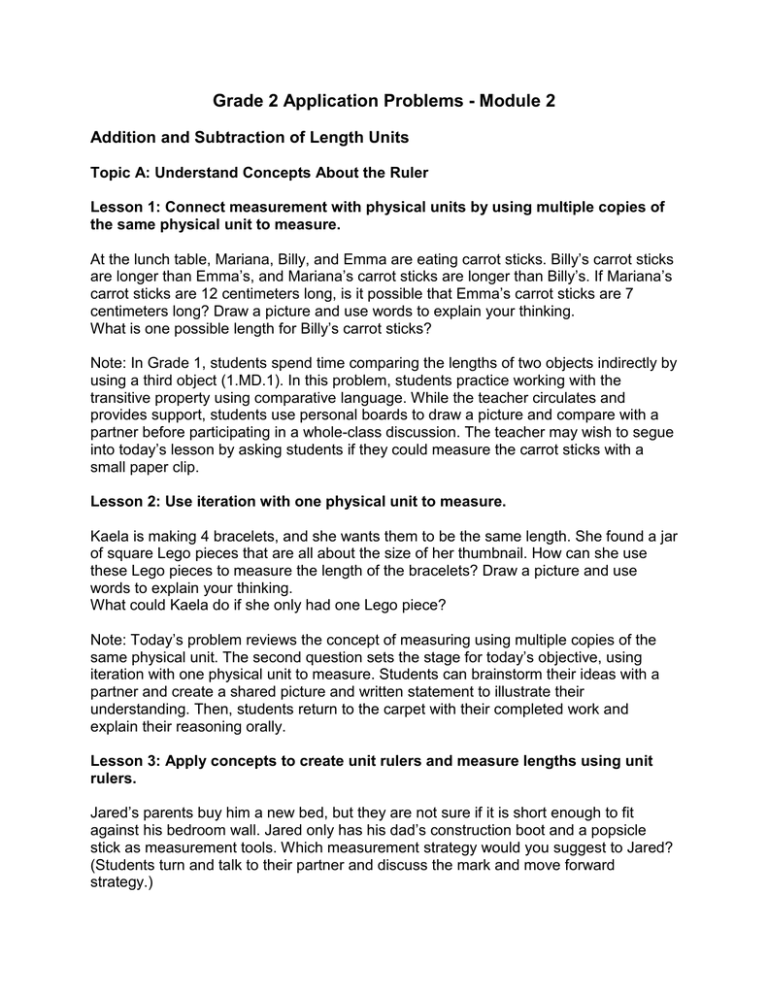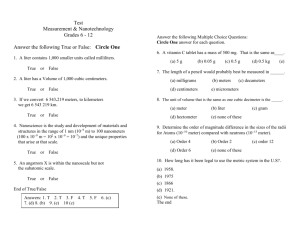Module 2
advertisement

Grade 2 Application Problems - Module 2 Addition and Subtraction of Length Units Topic A: Understand Concepts About the Ruler Lesson 1: Connect measurement with physical units by using multiple copies of the same physical unit to measure. At the lunch table, Mariana, Billy, and Emma are eating carrot sticks. Billy’s carrot sticks are longer than Emma’s, and Mariana’s carrot sticks are longer than Billy’s. If Mariana’s carrot sticks are 12 centimeters long, is it possible that Emma’s carrot sticks are 7 centimeters long? Draw a picture and use words to explain your thinking. What is one possible length for Billy’s carrot sticks? Note: In Grade 1, students spend time comparing the lengths of two objects indirectly by using a third object (1.MD.1). In this problem, students practice working with the transitive property using comparative language. While the teacher circulates and provides support, students use personal boards to draw a picture and compare with a partner before participating in a whole-class discussion. The teacher may wish to segue into today’s lesson by asking students if they could measure the carrot sticks with a small paper clip. Lesson 2: Use iteration with one physical unit to measure. Kaela is making 4 bracelets, and she wants them to be the same length. She found a jar of square Lego pieces that are all about the size of her thumbnail. How can she use these Lego pieces to measure the length of the bracelets? Draw a picture and use words to explain your thinking. What could Kaela do if she only had one Lego piece? Note: Today’s problem reviews the concept of measuring using multiple copies of the same physical unit. The second question sets the stage for today’s objective, using iteration with one physical unit to measure. Students can brainstorm their ideas with a partner and create a shared picture and written statement to illustrate their understanding. Then, students return to the carpet with their completed work and explain their reasoning orally. Lesson 3: Apply concepts to create unit rulers and measure lengths using unit rulers. Jared’s parents buy him a new bed, but they are not sure if it is short enough to fit against his bedroom wall. Jared only has his dad’s construction boot and a popsicle stick as measurement tools. Which measurement strategy would you suggest to Jared? (Students turn and talk to their partner and discuss the mark and move forward strategy.) Can Jared figure out if the new bed will fit in his bedroom? How do you know? Use numbers, pictures, or words to explain your thinking. Extension: Which tool would you use to measure, the popsicle stick or the construction boot? Why? Note: The first portion of this problem reviews using iteration with one physical unit to measure and asks students to recall the mark and move forward strategy. The second portion asks the student to make a comparison between the length of Jared’s bed and the length of his bedroom wall and decide if the bed is short enough to fit. During the second portion, students use personal white boards to draw a picture, adding numbers and words to support their conclusions. The extension portion is designed for accelerated learners, as this measurement concept of inverse relationship will not be addressed until Lesson 7. When all students have had a reasonable amount of time to work, they trade work with a partner. The teacher circulates and chooses a few students to share their partner’s work aloud. Topic B: Measure and Estimate Length Using Different Measurement Tools Lesson 4: Measure various objects using centimeter rulers and meter sticks. Cameron wants to draw a canoe that is 16 centimeters long. He has 16 centimeter cubes, a centimeter ruler, and 16 paperclips of various sizes in his desk. Which measurement tool would you recommend for Cameron? Why? Write a sentence to explain your thinking. What if Cameron was asked to paint a much larger, life-size canoe as scenery for the school play? Is there any other way he could measure it? (Students share responses orally.) Note: Today’s problem asks students to synthesize their understanding of choosing an appropriate measurement tool, one that is accurate and efficient. Since students are being asked to write, assign them partners such that each partnership has a strong writer who is comfortable with language and vocabulary. Students then share their responses in small groups. Highlight one or two exemplary responses after small group sharing. The second portion of the problem sets the stage for the introduction of meter sticks and meter tape as another measurement tool. Lesson 5: Develop estimation strategies by applying prior knowledge of length and using mental benchmarks. Jenna and Bobby are building a rope ladder for their treehouse. They would like the ladder to be about the length of a sports car. They want to use rope for the sides of the ladder and wooden rungs for the steps. Which measurement tools would you suggest that Jenna and Bobby use to measure the length of the rope and the length of the rungs for their ladder? Draw a picture and use words to explain your thinking. Note: Today’s problem asks students to choose the appropriate measurement tool by applying prior knowledge of length and making comparisons. Students work independently using personal boards and then compare their responses with a partner. The teacher listens in on conversations and invites a few students to share their responses with the whole class. The teacher may wish to return to this problem during the debrief segment to estimate the amount of rope needed to build the ladder. Topic C: Measure and Compare Lengths Using Different Length Units Lesson 6: Measure and compare lengths using centimeters and meters. Eve builds a block tower that reaches the height of her bedroom doorknob, which is one meter high. Her little sister knocks some blocks down. Eve measures her new tower, and it is 48 centimeters tall. How does Eve’s new tower compare to when it was first built? Draw a picture on your personal board and use numbers or words to explain your thinking. Note: Yesterday, students used mental benchmarks to estimate various lengths. This problem connects the concept of mental benchmarks to the language of comparisons. The question above is open-ended in nature; thus, student responses may vary from simple comparisons (e.g., it’s smaller now.) to exact calculations, or even to the observation that it is now about half the size of the original tower. This problem serves as a bridge to today’s lesson, where students are asked to measure and compare various lengths to determine which is longer and which is shorter. Lesson 7: Measure and compare lengths using standard metric length units and non-standard lengths units; relate measurement to unit size. Natalia, Chloe, and Lucas are making clay snakes. Natalia's snake is 16 centimeters. Chloe's snake is 5 centimeters shorter than Natalia's. How long is Chloe's snake? Draw a picture and use numbers to explain your thinking. Lucas's snake is 3 centimeters longer than Chloe's snake. Who has the longest snake: Natalia, Lucas, or Chloe? Add to your picture and use numbers to explain your thinking. Note: This two-step problem presents a challenge for students to extend their understanding of measuring and comparing. Students are asked to connect addition and subtraction concepts to comparison language and to draw a conclusion. Topic D: Relate Addition and Subtraction to Length Lesson 8: Solve addition and subtraction word problems using the ruler as a number line. For Valentine's Day, Suzie is mailing a painting to her Nana. The painting is 16 centimeters long. The gift box is 35 centimeters long. How much longer is the gift box than the painting? Draw a picture to show your work. Extension: What would happen if Suzie’s meter strip was torn and started at 1 centimeter instead of zero? Would she still be able to measure? (Students orally defend their reasoning.) Note: The problem allows for practice of compare with difference unknown word problems. The question sets the stage for today’s objective as students use their prior knowledge of movement on a number line (meter strip) to defend their reasoning as they think about Suzie’s torn meter strip. Lesson 9 : Concrete to abstract: measure lengths of string using measurement tools; represent length with tape diagrams to represent and compare the lengths. Mei’s frog leaped several centimeters. Then it leaped 34 centimeters. In all, it leaped 50 centimeters. How far did Mei’s frog leap at first? Draw a picture and write a number sentence to explain your thinking. Note: This add to with start unknown situation may be challenging for students. After students share their solutions, the teacher may wish to model problem solving using a tape diagram. This is in anticipation of today’s lesson, where students will be representing length using tape diagrams. Lesson 10: Apply conceptual understanding of measurement by solving two-step word problems. No Application Problem Given





